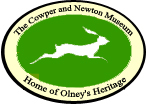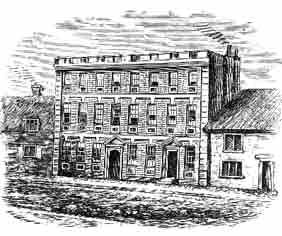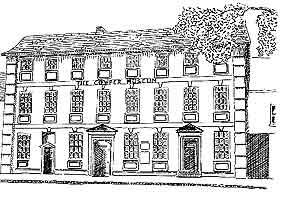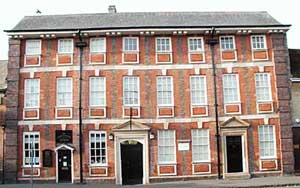|
THE MUSEUM PEOPLE
WORKS ORCHARD SIDE GARDENS |
 |
|
The Cowper and Newton Museum
|
|
Orchard Side
|
|
Orchard Side, from 1768-1786 the home of the poet and hymn-writer William Cowper, is situated on the south-east corner of the triangular Market Place in Olney: it now houses The Cowper and Newton Museum. Olney is a small, pretty and thriving market town in North Buckinghamshire situated in the Ouse Valley. It is famous for its connections with John Newton and William Cowper, and also for its annual Pancake Race. Look here for links to web sites about Olney.
Orchard Side is made up of two separate buildings with a central gateway. The two buildings were built in the late 17th century and the front brick facade with its pedimented doorways, pilasters and stone strings and dressings were added to connect the two buildings in the early 1700. Cowper lived in the western half of what appears from the outside to be a single house. Behind the building a long flower garden leads to a further garden containing Cowper's famous Summer House, where he wrote many of his poems. The eastern part of the building is now known as Gilpin House (after Cowper's poem "John Gilpin"). |
|
The History of Orchard Side
Tenants of the House and Adjoining Properties
|
|
Cowper's House, as the building became known in the 19th century, was for a time a school. In 1800 the building became available to rent. This coincided with Thomas Haddon's search for suitable property for a school. The school was furnished partly from the sale of several pieces of Cowper's effects, of which Haddon purchased several pieces of furniture, including a mirror. Years later the same mirror was presented to the museum by the daughters of Mr. Haddon's eldest son and is now in the Costume Gallery. Owing to a family tragedy in 1839 Haddon gave up the administration of the school.
By the time of Haddon's death in April 1845 the school had degenerated to a dame school. The Scottish travel writer and geologist Hugh Millar records in his book "First Impressions of England and Its People" that he found the " famed parlour vocal with the gabble of an infant school." He was sad to see that the walls were "sorely soiled and the plaster somewhat broken." The school days at Orchard Side had altered Cowper's home considerably. Miller found both the house and garden had changed greatly in the forty-five years since the poet's death. A partition had been removed from the parlour, increasing the space by half again for the purpose of creating a classroom; a wall now bi-sected the garden. In 1854 the garden containing the famed Summer House was sold separately. It was only re-united with the rest of the property in 1919 when the Trustees of the Museum were able to purchase the Summer House garden for £450. |
|
|



